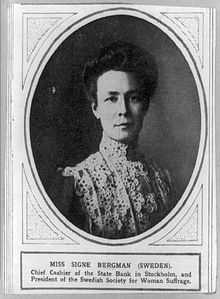Signe Bergman

Signe Wilhelmina Ulrika Bergman (10 April 1869 – 1960), was a Swedish feminist. She was the chairperson of the Landsföreningen för kvinnans politiska rösträtt or LKPR in 1914–1917 and the Swedish delegate to International Woman Suffrage Alliance in 1909–1920. She was the organiser of the congress of the International Woman Suffrage Alliance in Stockholm in 1911 and the editor of the paper of the LKPR, Rösträtt för kvinnor (Women suffrage).
Biography
Signe Bergman was born a member of a family of officials in Stockholm and was given a high but informal education. She spent some years in Great Britain, where she worked in the institute of her cousin Martina Bergman-Österberg, as well as an assistant to a researcher at the British Museum, before she returned to Sweden, where she worked as a clerk at the Sveriges allmänna hypoteksbank. Bergman lived alone in a time when it was considered more suitable for a professional middle class woman to share her flat with a female companion for modesty's sake.
Signe Bergman was one of the leading figures of the Swedish suffrage movement, if not the perhaps most famous during her lifetime. In 1906-14, she was a member of the central comity of the Stockholm section of the Landsföreningen för kvinnans politiska rösträtt; in 1907, she became a member of the central comity of the organisation as a whole; and from 1914 until 1917, she was its chairman. She was also the editor of the organisation's paper, and in 1909-20, she was a member of International Woman Suffrage Alliance and represented Sweden on several international suffrage congresses.
In an interview in the paper Idun in 1911, she explained why she became active in the fight for woman suffrage: "It was the second motion about women suffrage made by Carl Lindhagen which was exposed to mockery and simply put down. It was for our sake he fought, then should not women like me stand forward?"
Formally, Bergman was chairman 1914-1917, but in reality, she was pointed out as the central figure of the Swedish suffrage movement both by the its members as well as by the press from the start. This is illustrated by contemporary media, where she was frequently caricatured as the "Rösträttsgeneralen" (The Suffrage General). She was a social democrat, described as firm and effective, and is referred to as the dominant force within the organisations central comity and the brain behind its actions, collections and meetings. She was also the organiser of the congress of the International Woman Suffrage Alliance in Stockholm in 1911, which was described as a great success of the LKPR.
In 1911, the politically right wing chairman of the LKPR, Lydia Wahlström, resigned as chairman officially for health reasons. In reality, the LKPR, which had a policy of political neutrality, had adopted a new policy to boycott the political party who opposed woman suffrage. In reality, this meant that the LKPR was no longer political neutral, as the only Swedish partys who opposed woman suffrage was the conservative party. As Wahlström was herself a conservative, she resigned, which caused conflicts between right wing and left wing women in the LKPR. As Signe Bergman, who was regarded as the obvious choice for next chairman was known for her socialist opinions, the former and more apolitical chairman Anna Whitlock was regarded as a more non-controversial choice. Signe Bergman was therefore not formally made chairman until the conflicts had calmed down in 1914. In 1917, there was a majority in the parliament of parties favourable to women suffrage, but a motion of woman suffrage was still voted down. This caused Bergman to resign from her position.
References
- Barbro Hedwall (2011). Susanna Eriksson Lundqvist. red.. Vår rättmätiga plats. Om kvinnornas kamp för rösträtt.. (Our Rightful Place. About women's struggle for suffrage) Förlag Bonnier. ISBN 978-91-7424-119-8 (Swedish)
- Stig Hadenius, Torbjörn Nilsson & Gunnar Åselius (1996). Sveriges historia. Borås: Bonnier Albs. ISBN 91-34-51857-6.
- Svensk uppslagsbok. Malmö 1939
|